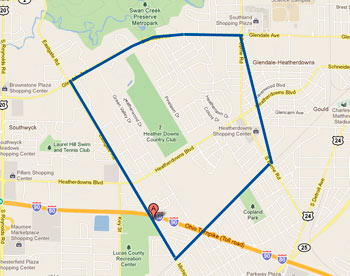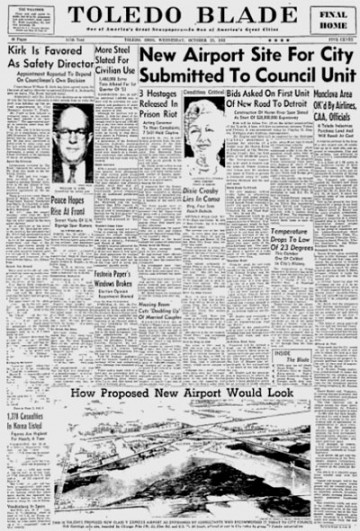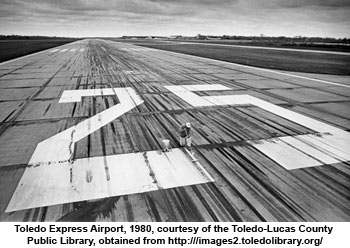(This is the first of two planned posts about the history of Toledo Express Airport)
After World War II, it made a lot of sense for Toledo’s civic leaders to push for a new, modern airport. It was a massive shove from Toledo’s greatest industrial names, however, that got the airport project known today as Toledo Express Airport off the ground and on its way to opening in 1955.
The Toledo Municipal Airport experience – more or less a debacle – left the city wanting an airport that suited the needs of the postwar era, and one that met the requirements of commercial airlines using it (one consideration was the coming of larger, and jet powered, aircraft, which required longer runways).
No one, however, could agree where. In the ten years it took to plan and build the $3.8 million airport, nineteen sites were discussed and discarded.
While a number of sites – Detwiler Marsh, near Fort Miami race track in Maumee, the Union Station area – were kicked around at first staring in late 1944, the Civil Aeronautics Administration arrived on three it liked: out near Holland, and two in South Toledo: Glendale and Heatherdowns.

City Council tagged Glendale as its top pick in 1946 (the approximate location is on the map at right), but to say it didn’t go over big with South Toledo residents would be putting it mildly. Council then made “the Holland site” its primary focus (an area bounded by Dorr St., McCord, Angola and Centennial roads), but, soil tests made it unsuitable.
So, new sites emerged: Stitt Road. Garden Road. Somewhere in Sylvania. The expansion of Municipal Airport was also discussed, but the Pennsylvania Railroad absolutely refused to budge its tracks.
This story from June 11, 1948 was typical of many covering the process: the City-County Plan Commission disclosed the airport-site-flavor-of-the-day was now east of Temperance, Michigan.
By 1950, a new site at McCord Road and Bancroft St. had emerged…well, you get the picture. I’m sure if they could have built it in Lake Erie, someone would have thought of…oh, look! Artificial Maumee Bay Isle Proposed For Toledo Airport: but at $10 million, the proposal went nowhere.

Shortly thereafter, Mayor Lloyd Roulet and the city’s aviation consultants, Leigh Fisher & Associates, put together what The Blade described as a “closely-guarded” plan that brought in Toledo’s driving force – big business – to get past the stage of finding a site.
On October 29, 1952, in what was described by The Blade as a surprise package “all neatly tied up as to land title, and approval of consultants, CAA and the airlines,” the proposal for today’s Toledo Express Airport was delivered to City Council. What was different this time was that title to the property, along Chicago Pike near Monclova, had been acquired by a group of six local industries.
I’m sure you’ve heard of the six local industries, because they would probably be at the top of anybody’s list of historic Toledo companies: Libbey-Owens-Ford, Owens-Illinois, Owens-Corning Fiberglas, Champion Spark Plug, Electric Auto-Lite, and Willys-Overland.
The companies generously volunteered to acquire the property by private purchase and offer it to the city at cost.
City Council promptly approved the scheme (next day, in fact). The plan, along with its unique financing scheme (industries, air carriers and users would ultimately pay two-thirds of the cost) was approved by voters the following May. No federal or state money was involved in the airport’s construction, something which drew praise from President Eisenhower himself.
Part two details the airport’s opening, and subsequent glory days, as Toledo finally had a modern airport to call its own.

Has Part two of this ever been published?
Alas, no. It’s on a long list. What’s worse is, I’ve had six years to get around to it!
Alas, no. It’s on a long list. What’s worse is, I’ve had six years to get around to it!